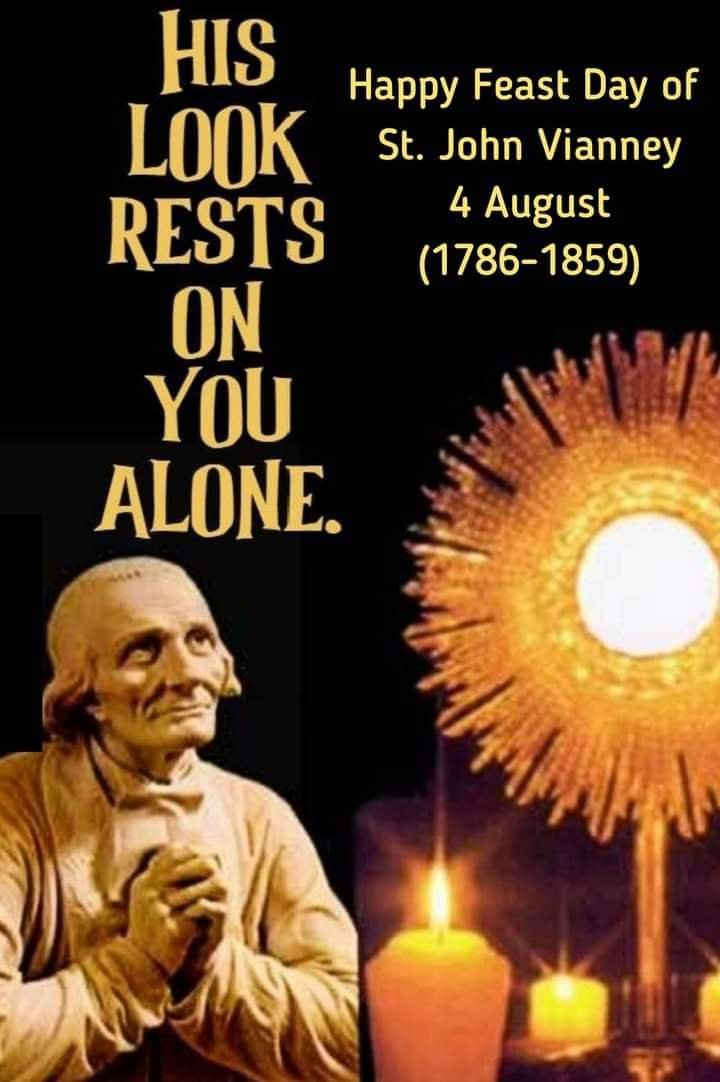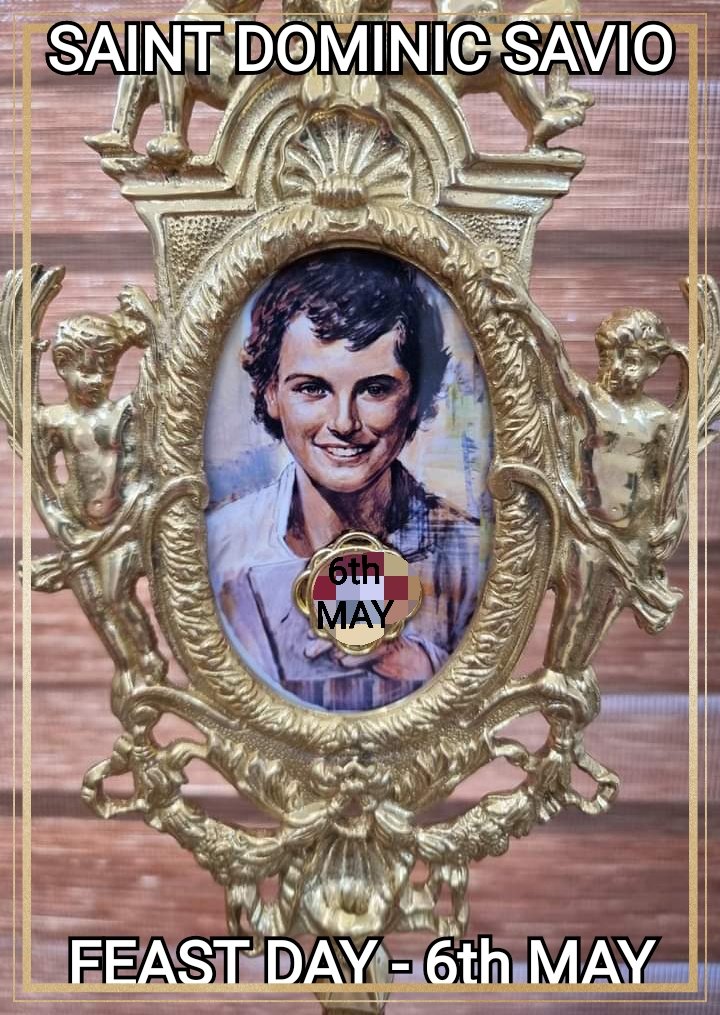FEAST OF SAINT JOHN MARIE VIANNEY
FEAST DAY – 4th AUGUST
John Vianney (born Jean-Baptiste-Marie Vianney; 8 May 1786 – 4 August 1859), venerated as Saint John Vianney, was a French Catholic priest who is venerated in the Catholic Church as a saint and as the patron saint of parish priests. He is often referred to as the “Curé d’Ars” (i.e. the parish priest of Ars), internationally known for his priestly and pastoral work in his parish in Ars, France.
This is because of the radical spiritual transformation of the community and its surroundings. Catholics attribute this to his saintly life, mortification, persevering ministry in the sacrament of confession, and ardent devotion to the Blessed Virgin Mary. His feast day is August 4 in the Novus Ordo calendar, is August 8 in the Missal of 1962 calendar, and is August 9 in the pre-1955 calendar.

Vianney was born on 8 May 1786, in the French town of Dardilly, France (near Lyon), and was baptized the same day. His parents, Matthieu Vianney and his wife Marie (Belize), had six children, of whom John was the fourth. The Vianneys were devout Catholics who helped the poor. Vianney’s paternal grandparents once gave hospitality to Benedict Joseph Labre, the patron saint of the homeless, who passed through Dardilly on his pilgrimage to Rome in 1770.
By 1790, the anticlerical Terror phase of the French Revolution forced many loyal priests to hide from the regime in order to carry out the sacraments in their parish. Even though to do so had been declared illegal, the Vianneys traveled to distant farms to attend Masses celebrated on the run. Realizing that such priests risked their lives day by day, Vianney began to look upon them as heroes.
He received his First Communion cathechetical instruction in a private home from two nuns whose communities had been dissolved during the Revolution. He made his first communion at the age of 13 in a neighbor’s kitchen. During the Mass, the windows were covered so that the light of the candles could not be seen from outside.

The Catholic Church was re-established in France in 1802 by Napoleon Bonaparte, resulting in religious peace throughout the country, culminating in a Concordat. By this time, Vianney was concerned about his future vocation and longed for an education. He was 20 when his father allowed him to leave the farm to be taught at a “presbytery school” in the neighboring village of Écully, conducted by the Abbé Balley.
The school taught arithmetic, history, geography and Latin. Vianney struggled with school, especially with Latin, since his past education had been interrupted by the French Revolution. Only because of Vianney’s deepest desire to be a priest—and Balley’s patience—did he persevere. Vianney’s studies were interrupted in 1809 when he was drafted into Napoleon’s armies.
He would have been exempt, as an ecclesiastical student, but Napoleon had withdrawn the exemption in certain dioceses because of his need for soldiers in his fight against Spain. Two days after he had to report at Lyons, he became ill and was hospitalized, during which time his draft left without him. Once released from the hospital, on 5 January, he was sent to Roanne for another draft.
He went into a church to pray, and fell behind the group. He met a young man who volunteered to guide him back to his group, but instead led him deep into the mountains of Le Forez, to the village of Les Noes, where deserters had gathered. Vianney lived there for fourteen months, hidden in the byre attached to a farmhouse, and under the care of Claudine Fayot, a widow with four children.

He assumed the name Jerome Vincent, and under that name, he opened a school for village children. Since the harsh weather isolated the town during the winter, the deserters were safe from gendarmes. However, after the snow melted, gendarmes came to the town constantly, searching for deserters. During these searches, Vianney hid inside stacks of fermenting hay in Fayot’s barn.
An imperial proclamation in March 1810 granted amnesty to all deserters, enabling Vianney to go back legally to Écully, where he resumed his studies. He was tonsured in 1811, and in 1812 he went to the minor seminary at Verrières-en-Forez. In autumn of 1813, he was sent to the major seminary at Lyons. Considered too slow, he was returned to Balley.
However, Balley persuaded the vicar general that Vianney’s piety was great enough to compensate for his ignorance, and the seminarian received minor orders and the subdiaconate on 2 July 1814, was ordained a deacon in June 1815, and was ordained priest on 12 August 1815 in the Couvent des Minimes de Grenoble. He said his first Mass the next day, and was appointed the assistant to Balley in Écully.
In 1818, shortly after the death of Balley, Vianney was appointed parish priest of the parish of Ars, a town of 230 inhabitants. When Vianney’s bishop first assigned him to Ars, he got lost trying to find the town. Two young men tending flocks in the fields pointed him in the right direction. With Catherine Lassagne and Benedicta Lardet, he established La Providence, a home for girls.
As parish priest, Vianney realized that the Revolution’s aftermath had resulted in religious ignorance and indifference, due to the devastation wrought on the Catholic Church in France. At the time, Sundays in rural areas were spent working in the fields, or dancing and drinking in taverns. Vianney spent time in the confessional and gave homilies against blasphemy and profane dancing.
If his parishioners did not give up this dancing, he refused them absolution. His stern sermons were later collected together in the famous “Sermons of the Curé of Ars,” along with his moral Catechetical Instructions. Vianney came to be known internationally, and people from distant places began travelling to consult him as early as 1827.
By 1855, the number of pilgrims had reached 20,000 a year. During the last ten years of his life, he spent 16 to 18 hours a day in the confessional. Even the bishop forbade him to attend the annual retreats of the diocesan clergy because of the souls awaiting him yonder. He spent at least 11 or 12 hours a day in the confessional during winter, and up to 16 in the summer.

In his article “How does the Church Respond to Suicide?” Shaun McAfee references an incident described in the book Cure of Ars:
“…a woman…told….Vianney that she was devastated because her husband had committed suicide. She wanted to approach the great priest but his line often lasted for hours and she could not reach him. She was ready to give up and in a moment of mystical insight that only a great saint can receive,…Vianney exclaimed through the crowd, “He is saved!”
The woman was incredulous so the saint repeated, stressing each word, “I tell you he is saved. He is in Purgatory, and you must pray for him. Between the parapet of the bridge and the water he had time to make an act of contrition.
Vianney had a great devotion to Saint Philomena. Vianney regarded her as his guardian and erected a chapel and shrine in honor of the saint. During May 1843, Vianney fell so ill he thought that his life was coming to its end. Vianney attributed his cure to her intercession.
Vianney yearned for the contemplative life of a monk, and four times ran away from Ars, the last time in 1853. He was a champion of the poor as a Franciscan tertiary and was a recipient of the coveted French Legion of Honour. On 4 August 1859, Vianney died at the age of 73. The bishop presided over his funeral with 300 priests and more than 6,000 people in attendance. Before he was buried, Vianney’s body was fitted with a wax mask.
On 3 October 1874 Pope Pius IX proclaimed him “venerable”; on 8 January 1905, Pope Pius X declared him Blessed and proposed him as a model to the parochial clergy. In 1925 John Mary Vianney was canonized by Pope Pius XI, who in 1929 made him patron saint of parish priests. In 1928 his feast day was inserted into the General Roman Calendar for celebration on 9 August.
Pope John XXIII’s 1960 revision, in which the Vigil of Saint Lawrence had a high rank, moved the feast to 8 August. Finally, the 1969 revision placed it on 4 August, the day of his death. In 1959, to commemorate the centenary of John Vianney’s death, Pope John XXIII issued the encyclical letter Sacerdotii nostri primordia.
John Paul II visited Ars in person in 1986 in connection with the bicentenary of Vianney’s birth and referred to him as a “rare example of a pastor acutely aware of his responsibilities … and a sign of courage for those who today experience the grace of being called to the priesthood.”

In honor of the 150th anniversary of Vianney’s death, Pope Benedict XVI declared a Year of the Priest, running from the Feast of the Sacred Heart 2009–2010. The Vatican Postal Service issued a set of stamps to commemorate the 150th Anniversary.
With the following words on 16 June 2009, Benedict XVI officially marked the beginning of the year dedicated to priests, “…On the forthcoming Solemnity of the Most Sacred Heart of Jesus, Friday 19 June 2009 – a day traditionally devoted to prayer for the sanctification of the clergy –, I have decided to inaugurate a ‘Year of the Priest’ in celebration of the 150th anniversary of the dies natalis of John Mary Vianney, the Patron Saint of parish priests worldwide…”

Pope Benedict XVI declared 19 June 2009 –19 June 2010 the Year of the Priests to encourage priests to strive for spiritual perfection. In the Pope’s words the Curé d’Ars is “a true example of a pastor at the service of Christ’s flock.”
There are statues of Vianney in many French churches and in Catholic churches throughout the world. Also, many parishes founded in the twentieth and twenty-first centuries are named after him. Some relics are kept in the Church of Notre-Dame de la Salette in Paris. John Vianney is remembered in the Anglican Communion with a commemoration on 4 August. Saint John Vianney is the Patron Saint of: Diocesan Priests, Parish Priests
PRAYER
In this world, dear God, indifference and passive attitudes toward religion, coupled with a love for material pleasure and comfort, seems to be common signs of our times. We seldom realize that we are pilgrim people, on our way to somewhere else.
Saint John Vianney, your faithful servant, was a man on a journey of life, with his goal before him at all times. His devotion and dedication throughout his life, make him an outstanding model of piety and wisdom.
Help us gain from him the vision to obtaining spiritual growth and strictly maintaining the faith in the Name of Jesus our Lord. Amen
Prayer to Saint John Vianney for Parish Priests
Saint John Vianney,
Your childhood dream was to be a Priest, to win souls for God. You endured years of toil and humiliation to attain the Priesthood. You became a priest truly after God’s own heart, totally devoted to the service of God’s people. The Church has exalted you as model priest and patron of all parish priests. Pray that God may give to His Church today, many more priests after His own Heart.
Pray for all the priests under your patronage, that they may be worthy representatives of Christ the Good Shepherd. May they wholeheartedly devote themselves to prayer and penance; be examples of humility and poverty and shining models of holiness. May their loving devotion to Jesus in the Eucharist and to Mary His Mother be the Twin Fountains of fruitfulness for their ministry. Amen.
(excerpt By Fr. Jason Vidrine, Diocese of Lafayette, Louisianna.)

Prayer for Priests:
Mary, Mother of Jesus,throw your mantle of purity over our priests.
Protect them, guide them, and keep them in your heart.
Be a Mother to them,
especially in times of discouragement and loneliness.
Love them and keep them belonging completely to Jesus.
Like Jesus, they, too, are your sons, so keep their hearts pure and virginal.
Keep their minds filled with Jesus, and put Jesus always on their lips,
so that he is the one they offer to sinner and to all they meet.
Mary, Mother of Jesus, be their Mother,
loving them and bringing them joy.
Take special care of sick and dying priests, and the ones most tempted.
Remember how they spent their youth and old age,
their entire lives serving and giving all to Jesus.
Mary, bless them and keep a special place for them in your heart.
Give them a piece of your heart, so beautiful and pure and immaculate,
so full of love and humility, so that they, too, can grow in the likeness of Christ.
Dear Mary, make them humble like you, and holy like Jesus. Amen.
(Prayer by Blessed Mother Teresa)
HAPPY FEAST OF SAINT JOHN MARIE VIANNEY TO ALL PRIESTS OF ALL PARISHES.

SAINT JOHN VIANNEY, PRAY FOR US ALL!







